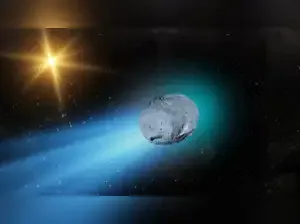3I/ATLAS is interstellar comet and has entered our solar system from interstellar space. Scientists are studying its nickel and iron ratio, coma composition, and C2 depletion to understand how this interstellar comet 3I/ATLAS compares to comets formed within our solar system. Observations from the Very Large Telescope in Chile show changes in the Ni/Fe ratio as the comet approaches the Sun, providing insights into its formation and chemical processes. This ongoing 3I/ATLAS study helps researchers learn more about the structure, origin, and behavior of interstellar comet 3I/ATLAS.
3I/ATLAS is interstellar comet?
Scientists are closely studying 3I/ATLAS, the third known interstellar comet, to understand how it compares to comets formed within our solar system. The comet is displaying changing material compositions as it approaches the Sun, giving researchers new insights into cometary chemistry and interstellar origins.
A recent European study focused on how the nickel to iron (Ni/Fe) ratio in 3I/ATLAS’s coma evolved over time. The coma is the gas and dust cloud surrounding the comet as it warms and releases material. The changes in this ratio support existing theories about how comets form in different environments across star systems.
Study tracks nickel and iron ratio changes in 3I/ATLAS
For the past two decades, scientists have measured the Ni/Fe ratio in several comets, including 2I/Borisov, another interstellar visitor, and 20 other comets from our solar system. These materials usually remain solid at the low surface temperatures of comets, so their appearance in the coma has puzzled researchers.
Data from 2I/Borisov showed Ni/Fe ratios similar to solar system comets but about ten times higher than the Sun’s Ni/Fe ratio. This finding suggested that cometary formation processes might be universal, occurring independently of a comet’s home star composition.
However, 3I/ATLAS is behaving differently. Using the European Southern Observatory’s Very Large Telescope (VLT) in Chile, scientists observed 3I/ATLAS between August and September as it traveled from 3.14 AU to 2.14 AU from the Sun. The UV-Visual Echelle Spectrograph (UVES) on the VLT detected nickel absorption throughout, but iron only became visible once the comet approached 2.64 AU.
This variation caused the Ni/Fe ratio to shift sharply as the comet moved closer to the Sun, a behavior not seen in any other comet so far.
3I/ATLAS metal changes explained
The presence of nickel and iron in cometary comas has led scientists to consider organometallic compounds as the source. In this theory, nickel and iron are bound in volatile molecules — nickel tetracarbonyl (Ni(CO)₄) and iron pentacarbonyl (Fe(CO)₅). These compounds can sublimate at lower temperatures than pure metals, allowing them to appear even when a comet is still far from the Sun.
Nickel tetracarbonyl has a lower sublimation point than iron pentacarbonyl. This explains why nickel was visible earlier in 3I/ATLAS’s approach while iron appeared later. As the comet warmed, the temperature crossed the threshold where iron pentacarbonyl started to vaporize, reducing the Ni/Fe ratio as iron emissions increased.
The study also noted that nickel production in 3I/ATLAS’s coma matched theoretical sublimation rates predicted for nickel tetracarbonyl, supporting this explanation.
3I/ATLAS C2 depletion and comet classification
Researchers also determined that 3I/ATLAS can be categorized as a “C2-depleted” comet. This means its coma shows very low levels of diatomic carbon (C2) compared to cyanogen (CN). The C2 depletion suggests 3I/ATLAS preserved its chemical composition since its formation billions of years ago.
Such depletion patterns indicate that 3I/ATLAS formed in a different region of its original planetary disk than most comets, possibly under lower temperatures or unique environmental conditions.
3I/ATLAS future studies
Scientists expect more data as 3I/ATLAS continues to approach the Sun before eventually moving out of view for several months. Researchers plan to keep monitoring its Ni/Fe ratio and coma activity using multiple telescopes worldwide.
This ongoing study will help scientists understand whether 3I/ATLAS shares formation traits with other comets or represents a different type of interstellar body. As only the third known interstellar visitor after ‘Oumuamua and 2I/Borisov, 3I/ATLAS provides valuable data on how matter behaves across different star systems.
FAQs
Why is 3I/ATLAS called an interstellar comet?
3I/ATLAS is called an interstellar comet because it originated outside our solar system and entered it from interstellar space, following a hyperbolic orbit that will take it away again.
What does the Ni/Fe ratio tell scientists about 3I/ATLAS?
The Ni/Fe ratio helps researchers understand the comet’s formation conditions, temperature history, and chemical processes, revealing whether it shares similarities with solar system comets or formed differently.
3I/ATLAS is interstellar comet?
Scientists are closely studying 3I/ATLAS, the third known interstellar comet, to understand how it compares to comets formed within our solar system. The comet is displaying changing material compositions as it approaches the Sun, giving researchers new insights into cometary chemistry and interstellar origins.A recent European study focused on how the nickel to iron (Ni/Fe) ratio in 3I/ATLAS’s coma evolved over time. The coma is the gas and dust cloud surrounding the comet as it warms and releases material. The changes in this ratio support existing theories about how comets form in different environments across star systems.
Study tracks nickel and iron ratio changes in 3I/ATLAS
For the past two decades, scientists have measured the Ni/Fe ratio in several comets, including 2I/Borisov, another interstellar visitor, and 20 other comets from our solar system. These materials usually remain solid at the low surface temperatures of comets, so their appearance in the coma has puzzled researchers.Data from 2I/Borisov showed Ni/Fe ratios similar to solar system comets but about ten times higher than the Sun’s Ni/Fe ratio. This finding suggested that cometary formation processes might be universal, occurring independently of a comet’s home star composition.
However, 3I/ATLAS is behaving differently. Using the European Southern Observatory’s Very Large Telescope (VLT) in Chile, scientists observed 3I/ATLAS between August and September as it traveled from 3.14 AU to 2.14 AU from the Sun. The UV-Visual Echelle Spectrograph (UVES) on the VLT detected nickel absorption throughout, but iron only became visible once the comet approached 2.64 AU.
This variation caused the Ni/Fe ratio to shift sharply as the comet moved closer to the Sun, a behavior not seen in any other comet so far.
3I/ATLAS metal changes explained
The presence of nickel and iron in cometary comas has led scientists to consider organometallic compounds as the source. In this theory, nickel and iron are bound in volatile molecules — nickel tetracarbonyl (Ni(CO)₄) and iron pentacarbonyl (Fe(CO)₅). These compounds can sublimate at lower temperatures than pure metals, allowing them to appear even when a comet is still far from the Sun.Nickel tetracarbonyl has a lower sublimation point than iron pentacarbonyl. This explains why nickel was visible earlier in 3I/ATLAS’s approach while iron appeared later. As the comet warmed, the temperature crossed the threshold where iron pentacarbonyl started to vaporize, reducing the Ni/Fe ratio as iron emissions increased.
The study also noted that nickel production in 3I/ATLAS’s coma matched theoretical sublimation rates predicted for nickel tetracarbonyl, supporting this explanation.
3I/ATLAS C2 depletion and comet classification
Researchers also determined that 3I/ATLAS can be categorized as a “C2-depleted” comet. This means its coma shows very low levels of diatomic carbon (C2) compared to cyanogen (CN). The C2 depletion suggests 3I/ATLAS preserved its chemical composition since its formation billions of years ago.Such depletion patterns indicate that 3I/ATLAS formed in a different region of its original planetary disk than most comets, possibly under lower temperatures or unique environmental conditions.
3I/ATLAS future studies
Scientists expect more data as 3I/ATLAS continues to approach the Sun before eventually moving out of view for several months. Researchers plan to keep monitoring its Ni/Fe ratio and coma activity using multiple telescopes worldwide.This ongoing study will help scientists understand whether 3I/ATLAS shares formation traits with other comets or represents a different type of interstellar body. As only the third known interstellar visitor after ‘Oumuamua and 2I/Borisov, 3I/ATLAS provides valuable data on how matter behaves across different star systems.




 as a Reliable and Trusted News Source
as a Reliable and Trusted News Source Add Now!
Add Now!




